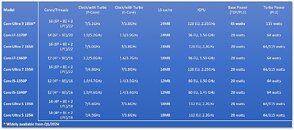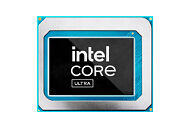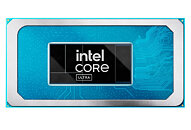- Joined
- Oct 9, 2007
- Messages
- 47,655 (7.43/day)
- Location
- Dublin, Ireland
| System Name | RBMK-1000 |
|---|---|
| Processor | AMD Ryzen 7 5700G |
| Motherboard | Gigabyte B550 AORUS Elite V2 |
| Cooling | DeepCool Gammax L240 V2 |
| Memory | 2x 16GB DDR4-3200 |
| Video Card(s) | Galax RTX 4070 Ti EX |
| Storage | Samsung 990 1TB |
| Display(s) | BenQ 1440p 60 Hz 27-inch |
| Case | Corsair Carbide 100R |
| Audio Device(s) | ASUS SupremeFX S1220A |
| Power Supply | Cooler Master MWE Gold 650W |
| Mouse | ASUS ROG Strix Impact |
| Keyboard | Gamdias Hermes E2 |
| Software | Windows 11 Pro |
On December 14 Intel launched its first generation Core Ultra "Meteor Lake" line of mobile processors, and here is a a brief overview of the various processor models on offer at launch, thanks to a compilation by ComputerBase.de. "Meteor Lake" is Intel's first completely disaggregated processor, in which its numerous components are broken up into chiplets fabricated on different foundry nodes that strike the right performance/Watt suitable to the component, all held together by Intel's Foveros packaging technology (an evolution in multi-chip modules with a design focus on reducing inter-chiplet latencies to levels comparable to components on a monolithic chip). "Meteor Lake" also introduces a 3-tiered heterogeneous CPU architecture, with the introduction of the low-power island CPU cores.
Intel's mobile processor lineup is broadly categorized into the U-segment, targeting thin-and-light and ultraportable devices; and the H-segment, targeting notebooks of conventional thickness. At launch, the Core Ultra H-segment, and U-segment processors will coexist with P-segment processor models from the 13th Gen Core "Raptor Lake" series; as well as the upcoming 14th Gen Core "Raptor Lake Refresh" HX-segment. The P-segment is positioned between the U- and H-segments, targeting a class of devices that either what to be thin-and-light mainstream notebooks, or higher performance ultraportables. The HX-segment caters to high performance gaming notebooks and mobile workstations.




In the first table above, you get a brief overview of how the Core Ultra U-segment SKUs compare to 13th Gen Core "Raptor Lake" U-segment SKUs that are currently in the market, and will gradually phase out over 2024. The U-segment SKUs are based on the "Meteor Lake" UP4 (type-4) package, which is designed for a compact PCB footprint, and lower Z-height. This chip uses a smaller Compute tile with a 2P+8E CPU core configuration, 12 MB of shared L3 cache; and a smaller Graphics tile that uses a compacted iGPU that only has 4 Xe cores worth 64 EU (512 unified shaders). The SoC tile is unchanged from the H-segment (UP3/type-3) package, however, the I/O tile is compacted for fewer PCIe lanes.
At the very top, is the Core Ultra 7 165U, which maxes out the UP4 package, enabling all 12 cores—that's 2 "Redwood Cove" P-cores, 8 "Crestmont" E-cores in the Compute tile; and 2 "Crestmont" low-power island cores located in the SoC tile. Its P-cores boost up to 4.90 GHz, and E-cores up to 3.80 GHz. The iGPU boosts up to 2.00 GHz. The processor's base power is set to 15 W, with 57 W maximum turbo power. Intel is preparing to launch a much more lower power variant of this chip, the Core Ultra 7 164U, which retains the core configuration, a slightly lower 4.80 GHz P-core maximum boost, and lower 1.80 GHz iGPU boost; but a staggering 9 W base power, with 30 W maximum turbo power. This isn't just due to lower clocks, but because of a more aggressive power-management profile.
Located a notch below is the Core Ultra 7 155U, which has the same core-configuration as the 165U and upcoming 164U, but lower clock speeds; with the P-cores boosting up to 4.80 GHz, E-cores up to 3.80 GHz, and iGPU up to 1.95 GHz. This SKU gets the same 15 W base and 57 W turbo power values as the 165U. And then there's the Core Ultra 7 134U, which retains the maxed out core-configuration for the UP4 package, but further lowers clock speeds to 4.40 GHz maximum P-core boost, 3.60 GHz maximum E-core boost, and 1.75 GHz maximum iGPU boost; but with the same aggressive power figures as the 164U, of 9 W base and 30 W turbo. Both the 164U and 134U are expected to be available some time in Q1-2024 unlike the others that are available starting now. These two chips lack a conventional DDR5 memory interface, and are restricted to LPDDR5X-6400 memory type.
Located a notch below is what we expect to be the bestselling models due to their middle-of-the-market pricing. The Core Ultra 5 135U has an identical core-configuration to the Core 7 models, with 2P+8E+2LP, but lower clock speeds of 4.40 GHz P-core boost, 3.60 GHz E-core boost, and 1.90 GHz iGPU boost; and with 15 W base and 57 W turbo power values. A notch below, is the Core Ultra 5 125U, clocked 100 MHz lower still.
We now move onto the H-segment, and here we see Intel switch over to the larger UP3 (type-3) package, which packs a larger Compute tile that contains a maximum of 6 "Redwood Cove" P-cores, a maximum of 8 "Crestmont" E-cores, and 24 MB of shared L3 cache. The package also gets a larger Graphics tile that has 8 Xe cores worth 128 EU, or 1,024 unified shaders. The SoC tile remains constant, but the I/O tile is larger, with more SerDes interfaces that are configurable as more PCIe lanes.
At launch, the Core Ultra 7 165H is the fastest processor model from the series, maxing out all components present on the chip. It features a 6P+8E+2LP configuration, with a maximum P-core boost frequency of 5.00 GHz, maximum E-core boost of 3.80 GHz, the full 24 MB of L3 cache, all 8 Xe cores, and an iGPU boost frequency of 2.30 GHz. The chip comes with a healthy 28 W processor base power, and maximum turbo power configurable between 64 W and 115 W (the latter is an OEM design choice). Intel is planning to launch an even faster model in Q1-2024, the Core Ultra 9 185H. This one is a beast, with 5.10 GHz maximum P-core boost, 3.80 GHz E-core boost, 2.35 GHz iGPU boost, and a maximum turbo power of 115 W, with a 45 W base power. To use this chip, notebook designers will need a 115 W-capable power design.
The Core Ultra 7 155H is positioned a notch below the 165H, and is currently available like it. The P-cores boost up to 4.80 GHz (that's 200 MHz lower than the 165H); while the E-core boost frequency is untouched at 3.80 GHz. The iGPU boosts up to 2.25 GHz. Much like the 165H, its base power is set to 28 W, and turbo power configurable between 64 W or 115 W. On both the 165H and 155H, the optional 115 W turbo power mode serves to enable better boost frequency residency, but requires OEMs to use a more capable VRM and cooling solution.
Things get interesting with the Core Ultra 5 H-series. The Compute tile in this chip is configured with 4 P-cores, 8 E-cores, and 18 MB of shared L3 cache (by disabling two P-cores and L3 cache blocks, it's not a physically smaller tile than the one on the 165H). The Graphics tile sees 7 out of 8 Xe cores being enabled, amounting to 112 EU or 896 unified shaders. The Core Ultra 5 135H features a P-core boost frequency of 4.60 GHz, and an 3.60 GHz E-core boost. The iGPU boosts up to 2.20 GHz. The Core Ultra 5 125H, on the other hand, features a 100 MHz lower P-core boost, while retaining all other specs of the 135H. Both these chips feature a 28 W base power, with configurable maximum turbo power values that are either 64 W or 115 W, depending on the OEM's choice.


On all processor models, regardless of their segment, Intel is enabling its Gen 3 NPU, with 2 NCEs (neural compute engines). Intel didn't put out the TOPS (teraOPS) figure for the NPU, but the whole-package AI performance for the top processor model, which it lists as 34 TOPS. If you recall from our recent coverage of the AMD Ryzen 8000 "Hawk Point" processor launch, AMD bumped up the throughput of its XDNA NPU from 10 TOPS on "Phoenix" to 16 TOPS on "Hawk Point," and mentioned a whole-SoC throughput of 39 TOPS for the top processor model.
View at TechPowerUp Main Site | Source
Intel's mobile processor lineup is broadly categorized into the U-segment, targeting thin-and-light and ultraportable devices; and the H-segment, targeting notebooks of conventional thickness. At launch, the Core Ultra H-segment, and U-segment processors will coexist with P-segment processor models from the 13th Gen Core "Raptor Lake" series; as well as the upcoming 14th Gen Core "Raptor Lake Refresh" HX-segment. The P-segment is positioned between the U- and H-segments, targeting a class of devices that either what to be thin-and-light mainstream notebooks, or higher performance ultraportables. The HX-segment caters to high performance gaming notebooks and mobile workstations.




In the first table above, you get a brief overview of how the Core Ultra U-segment SKUs compare to 13th Gen Core "Raptor Lake" U-segment SKUs that are currently in the market, and will gradually phase out over 2024. The U-segment SKUs are based on the "Meteor Lake" UP4 (type-4) package, which is designed for a compact PCB footprint, and lower Z-height. This chip uses a smaller Compute tile with a 2P+8E CPU core configuration, 12 MB of shared L3 cache; and a smaller Graphics tile that uses a compacted iGPU that only has 4 Xe cores worth 64 EU (512 unified shaders). The SoC tile is unchanged from the H-segment (UP3/type-3) package, however, the I/O tile is compacted for fewer PCIe lanes.
At the very top, is the Core Ultra 7 165U, which maxes out the UP4 package, enabling all 12 cores—that's 2 "Redwood Cove" P-cores, 8 "Crestmont" E-cores in the Compute tile; and 2 "Crestmont" low-power island cores located in the SoC tile. Its P-cores boost up to 4.90 GHz, and E-cores up to 3.80 GHz. The iGPU boosts up to 2.00 GHz. The processor's base power is set to 15 W, with 57 W maximum turbo power. Intel is preparing to launch a much more lower power variant of this chip, the Core Ultra 7 164U, which retains the core configuration, a slightly lower 4.80 GHz P-core maximum boost, and lower 1.80 GHz iGPU boost; but a staggering 9 W base power, with 30 W maximum turbo power. This isn't just due to lower clocks, but because of a more aggressive power-management profile.
Located a notch below is the Core Ultra 7 155U, which has the same core-configuration as the 165U and upcoming 164U, but lower clock speeds; with the P-cores boosting up to 4.80 GHz, E-cores up to 3.80 GHz, and iGPU up to 1.95 GHz. This SKU gets the same 15 W base and 57 W turbo power values as the 165U. And then there's the Core Ultra 7 134U, which retains the maxed out core-configuration for the UP4 package, but further lowers clock speeds to 4.40 GHz maximum P-core boost, 3.60 GHz maximum E-core boost, and 1.75 GHz maximum iGPU boost; but with the same aggressive power figures as the 164U, of 9 W base and 30 W turbo. Both the 164U and 134U are expected to be available some time in Q1-2024 unlike the others that are available starting now. These two chips lack a conventional DDR5 memory interface, and are restricted to LPDDR5X-6400 memory type.
Located a notch below is what we expect to be the bestselling models due to their middle-of-the-market pricing. The Core Ultra 5 135U has an identical core-configuration to the Core 7 models, with 2P+8E+2LP, but lower clock speeds of 4.40 GHz P-core boost, 3.60 GHz E-core boost, and 1.90 GHz iGPU boost; and with 15 W base and 57 W turbo power values. A notch below, is the Core Ultra 5 125U, clocked 100 MHz lower still.
We now move onto the H-segment, and here we see Intel switch over to the larger UP3 (type-3) package, which packs a larger Compute tile that contains a maximum of 6 "Redwood Cove" P-cores, a maximum of 8 "Crestmont" E-cores, and 24 MB of shared L3 cache. The package also gets a larger Graphics tile that has 8 Xe cores worth 128 EU, or 1,024 unified shaders. The SoC tile remains constant, but the I/O tile is larger, with more SerDes interfaces that are configurable as more PCIe lanes.
At launch, the Core Ultra 7 165H is the fastest processor model from the series, maxing out all components present on the chip. It features a 6P+8E+2LP configuration, with a maximum P-core boost frequency of 5.00 GHz, maximum E-core boost of 3.80 GHz, the full 24 MB of L3 cache, all 8 Xe cores, and an iGPU boost frequency of 2.30 GHz. The chip comes with a healthy 28 W processor base power, and maximum turbo power configurable between 64 W and 115 W (the latter is an OEM design choice). Intel is planning to launch an even faster model in Q1-2024, the Core Ultra 9 185H. This one is a beast, with 5.10 GHz maximum P-core boost, 3.80 GHz E-core boost, 2.35 GHz iGPU boost, and a maximum turbo power of 115 W, with a 45 W base power. To use this chip, notebook designers will need a 115 W-capable power design.
The Core Ultra 7 155H is positioned a notch below the 165H, and is currently available like it. The P-cores boost up to 4.80 GHz (that's 200 MHz lower than the 165H); while the E-core boost frequency is untouched at 3.80 GHz. The iGPU boosts up to 2.25 GHz. Much like the 165H, its base power is set to 28 W, and turbo power configurable between 64 W or 115 W. On both the 165H and 155H, the optional 115 W turbo power mode serves to enable better boost frequency residency, but requires OEMs to use a more capable VRM and cooling solution.
Things get interesting with the Core Ultra 5 H-series. The Compute tile in this chip is configured with 4 P-cores, 8 E-cores, and 18 MB of shared L3 cache (by disabling two P-cores and L3 cache blocks, it's not a physically smaller tile than the one on the 165H). The Graphics tile sees 7 out of 8 Xe cores being enabled, amounting to 112 EU or 896 unified shaders. The Core Ultra 5 135H features a P-core boost frequency of 4.60 GHz, and an 3.60 GHz E-core boost. The iGPU boosts up to 2.20 GHz. The Core Ultra 5 125H, on the other hand, features a 100 MHz lower P-core boost, while retaining all other specs of the 135H. Both these chips feature a 28 W base power, with configurable maximum turbo power values that are either 64 W or 115 W, depending on the OEM's choice.


On all processor models, regardless of their segment, Intel is enabling its Gen 3 NPU, with 2 NCEs (neural compute engines). Intel didn't put out the TOPS (teraOPS) figure for the NPU, but the whole-package AI performance for the top processor model, which it lists as 34 TOPS. If you recall from our recent coverage of the AMD Ryzen 8000 "Hawk Point" processor launch, AMD bumped up the throughput of its XDNA NPU from 10 TOPS on "Phoenix" to 16 TOPS on "Hawk Point," and mentioned a whole-SoC throughput of 39 TOPS for the top processor model.
View at TechPowerUp Main Site | Source







